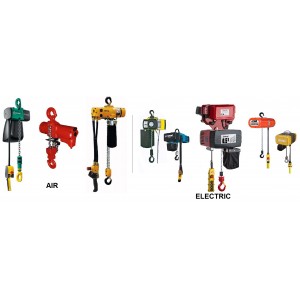
A hoist is a device that is used to lift, re-position and
lower loads that cannot be done without risk by a person alone. Hoists play a
big part in many day-to-day activities that we easily overlook, such as the automotive, engineering, and construction industries. Different
hoist designs are employed depending on its need and surroundings.
Here we look at the differences along with the pros and cons
of 2 of the most popular types of powered hoists on the market today!
Both an air hoist (pneumatic) and an electric hoist are both put to use
for lifting and lowering loads in all industries across the world. They both
visually look very similar but do have differences, the main one being how they are powered - compressed air or electricity.
An Air Hoist, also known as a pneumatic hoist is controlled
by compressed air pressure and is operated using a pendant
control. Due to the pendant controller operation,
it means the hoist can be moved from a safe distance and often at a slower pace than an
electric hoist. Having manual control gives variable speed and handling which
can be used for more delicate projects and accurate positioning of loads. The
unit weight is also a lot lower compared to an electric hoist due to having
fewer components, this makes them more mobile and easier to handle for the
user. Air hoists also have no cool-down time, complete with a self-cooling
gearbox means they can be operated continuously with no risks to the user or
breakages to the hoist. Air powered hoists are ideal for areas where there is no electric power supply or when using electrics could present a hazard.
An electric hoist is effortless to use, similarly to the air hoist they are powered and controlled by a push-button control panel. The power output is a key consideration with these hoists as they come in a range of power supply's - 110volt, 230 volt or 415volt - 3 phase.
These hoists come complete with a rated motor and brake to ensure loads are manoeuvred correctly and safely. A higher load capacity is available with all-electric hoists due to their heavy-duty chain function. Electric hoists also work at a faster pace than an air hoist which in turn will increase the level of productivity and reduce costs.
The flexibility
in design and lifting techniques is a significant benefit to both electric and
air hoists, heavy loads can be moved and repositioned in any direction or place
needed. Using hoist equipment reduces strain on the user resulting in less
injury and long-term health issues usually caused by the movement of heavy
loads manually.
Choosing which hoist is best for you depends on the service and area you wish to use the hoist for and the power supply – electric or compressed air. Many hoists can be used for multiple lifting tasks however if you want the best for you as a user and are unsure which to choose, feel free to contact Lifting Gear Direct where we will be happy to assist with any lifting equipment questions.